专业英语重点句子(带单词翻译版)
财务管理专业英语 句子及单词翻译

Financial management is an integrated decision-making process concerned with acquiring, financing, and managing assets to accomplish some overall goal within a business entity.财务管理是为了实现一个公司总体目标而进行的涉及到获取、融资和资产管理的综合决策过程。
Decisions involving a firm’s short-term assets and liabilities refer to working capital management.决断涉及一个公司的短期的资产和负债提到营运资金管理The firm’s long-term financing decisions concern the right-hand side of the balance sheet.该公司的长期融资决断股份资产负债表的右边。
This is an important decision as the legal structure affects the financial risk faced by the owners of the company.这是一个重要的决定作为法律结构影响金融风险面对附近的的业主的公司。
The board includes some members of top management(executive directors), but should also include individuals from outside the company(non-executive directors).董事会包括有些隶属于高层管理人员(执行董事),但将也包括个体从外公司(非执行董事)。
Maximization of shareholder wealth focuses only on stockholders whereas maximization of firm value encompasses all financial claimholders including common stockholders, debt holders, and preferred stockholders.股东财富最大化只集中于股东,而企业价值最大化包含所有的财务债券持有者,包括普通股股东,债权人和优先股股东。
英语专业综合教程4课后习题解释句子&英译汉
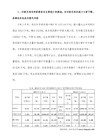
Unit 6
1. July4 is one of the times when the American in me feels a twinge of unease aboutthe great lacunae in our children’s understanding of who they are and isprompted to fill the gaps.
P: The human imagination hadbeen exhausted and stopped at the wreckage of the first ruined city and failedto reach even the outskirts of Nagasaki.
5. Weseem to need, in addition, some other picture to counterpoise against ruinedNagasaki.
2. Thatabsence, even more than wreckage, contains the heart of the matter.
P: That vanished city ratherthan its remains represents the true measure of the event.
专业英语重点句子(带单词翻译版)

Unit 1 (5个)1.Materials science and engineering (MSE) is an interdisciplinary field concerned with inventing new materials and improving previously known materials by developing a deeper understanding of the microstructure-composition-synthesis-processing relationships.2.Materials scientists and engineers not only deal with the development of materials, but also with the synthesis and processing of materials and manufacturing processes related to the production of components.3.One of the most important functions of materials scientists and engineers is to establish the relationships between a material or a device’s properties and performance and the microstructure of that material, its composition, and the way the material or the device was synthesized and processed.4.In materials science, the emphasis is on the underlying relationships between the synthesis and processing, structure, and properties of materials.5.In materials engineering, the focus is on how to translate or transform materials intoa useful device or structure.Unit 2(3个)6.What is also fascinating about van der Waals forces is that they begin as inter actions between atoms and molecules that ultimately lead to considerable forces between fine particles of any material.7. We make use of metal and ceramic powders (dry or slurries) in processing many ceramic and metallic materials through routes collectively known as powder processing (Processing technique for metals involving the solid-state bonding of a fine grained powder into a fully dense product).8.We can accomplish this by introducing like charges on the particles (electrostatic stabilization) or adsorbing soap like surfactant molecules on the surfaces of particles (steric stabilization).Unit 3(8个)9.The Si-O bond in the SiO44- structure in about 50 percent covalent and 50 percent ionic according to calculations from Pauling’s equation.10.The tetrahedral coordination of SiO44- satisfies the directionality requirement of covalent bonding and the radius ratio requirement of ionic bonding.11.If two corners of each SiO44-tetrahedron are bonded with the corners of othertetrahedra, a chain or ring structure with the unit chemical formula of SiO32- results.12.Silicate sheet structure form when three corners in the same plane of a silicate tetrahedron are bonded to the corners of three silicate tetrahedra.13.The mineral['mɪnərəl](矿物的,矿物) kaolinite['keɪəlɪnaɪt] (高岭石) consists (in its pure form) of every small, flat plates roughly hexagonal[hek'sæɡənəl](六边的,六角形的) in shape, with their average size being about 0.7um in diameter[daɪ'æmɪtə](直径)and 0.05 um thick.14.Another example of a sheet silicate is the mineral talc [tælk](滑石;云母), in which a sheet of Mg3(OH)24+ bonds with two outer-layer Si2O52- sheets (one on each side) to form a composite['kɒmpəzɪt](复合的;合成的)sheet with the unit chemical formula['fɔːmjʊlə](公式,方程式) Mg3(OH)2(Si2O5)2.15.Crystalline['krɪst(ə)laɪn](结晶的)silica exists in several polymorphic[,pɒlɪ'mɔːfɪk](多态的)forms that correspond to different ways in which the silicate tetrahedral are arranged with all corners shared.16.The most stable forms of silica and the temperature ranges in which they exist at atmospheric pressure are low quartz[kwɔːts](石英) below 573℃, high quartz between 573 to 867℃, high tridymite['trɪdɪmaɪt](鳞石英)between 867 and 1470℃, and high cristobite[kris'təu,bəlait](方石英) between 1470 and 1710℃.Unit 4(15个)17.Point defects(点缺陷)are localized['lokə'laɪzd](局部的;地区的;小范围的) disruptions[dɪs'rʌpʃən](破坏)in otherwise perfect atomic or ionic arrangements in a crystal structure.18.These imperfections, may be introduced by movement of the atoms or ions when they gain energy by heating, during processing of the material, by introduction of impurities, or doping[dop](掺杂).19.An important "point" about point defects is that although the defect occurs at one or two sites, their presence is "felt" over much larger distances in the crystalline material.20. When atoms or ions are missing (i.e., when vacancies are present), the overall randomness['rændəmnɪs](随意;无安排;不可测性) or entropy['entrəpɪ](熵) of the material increases, which increases the thermodynamic[,θɜːməʊdaɪ'næmɪk](热力学的)stability of a crystalline material.21.Vacancies['vekənsi](空位)play an important role in determining the rate at whichatoms or ions can move around, or diffuse[dɪ'f juːz](弥散,扩散)in a solid material, especially in pure metals.22.If we conduct(管理;引导;表现) this sintering['sɪntərɪŋ](烧结) treatment in a reducing or inert atmosphere (e.g., hydrogen or nitrogen), some of the oxygen ions from BaTiOa will leave the material in the form of oxygen gas.23.In some cases, we can introduce vacancies at specific ion sites so as to enhance the movement of ions in ceramic materials, which can help sinter ceramics[ɪn'hɑːns](提高;加强;增加) at lower temperatures.24.At room temperature(~298K), the concentration [kɒns(ə)n'treɪʃ(ə)n](集中,浓度)of vacancies is small, but the concentration of vacancies increases exponentially[,ɛkspo'nɛnʃəli](以指数方式) as we increase the temperature, as shown by the following Arrhenius type behavior:25.Interstitial[,ɪntə'stɪʃ(ə)l](间质的;空隙的;填隙的) atoms or ions,although much smaller than the atoms or ions located at the lattice['lætɪs](晶格;格子) points,are still larger than the interstitial sites that they occupy; consequently, the surrounding crystal region['riːdʒ(ə)n](范围) is compressed and distorted[dɪs'tɔrtɪd](扭曲).26.Interstitial atoms such as hydrogen['haɪdrədʒ(ə)n](氢)are often present as impurities; whereas[weər'æz](然而;鉴于;反之) carbon atoms are intentionally added to iron to produce steel.27.If there are dislocations(变位;位移;断错) in the crystals trying to move around these types of defects, they face a resistance to their motion, making it difficult to create permanent deformation(永久性变形) in metals and alloys.28.Substitutional[,sʌbstə'tjʊʃənl](置换)atoms or ions may either be larger than the normal atoms or ions in the crystal structure, in which case the surrounding inter-atomic spacings are reduced, or smaller causing the surrounding atoms to have larger inter-atomic spacings.29.Whether atoms or ions added go into interstitial or substitutional sites depends upon the size and valence of guest atoms or ions compared to the size and valence of host ions.Unit 5(10个)30.Semiconductors(半导体) which do not contain appreciable[ə'priːʃəb(ə)l](可感知的;可评估的;相当可观的) levels of dopants or impurities are known as intrinsic[ɪn'trɪnsɪk](本质的,固有的)semiconductors, When we add small concentrations of P or B to silicon crystal, these atoms occupy crystallographic[,krɪstəlɑ'ɡræfɪk](结晶的)sites where silicon atoms usually reside(住,居住;属于).31.The result is each P atom added has one "extra" electron that cannot pair with a Si atom to form a fifth Si-P bond.32.The entire microelectronics[,maɪkrəʊɪlek'trɒnɪks]微电子学) industry, as we know it today, would not exist if we did not have a good understanding of the diffusion of different atoms into silicon or other semiconductors.33.Strong covalent[,ko'velənt](共价的)and ionic bonds along with microstructural features contribute to the relatively poor electrical conductivity exhibited[ɪg'zɪbɪt] by many ceramics.34.The ability of ions to diffuse and provide a pathway for electrical conduction plays an important role in enabling these applications.35.This is one of the major reasons why we use polyethylene terephthalate (PET聚对苯二甲酸乙二醇酯) to make bottles which ensure that the carbonated beverages['bev(ə)rɪdʒ](饮料) they contain will not loose their fizz(兴奋,活力;嘶嘶声;充气饮料) for a reasonable period of time.36.In reality, aluminum[ə'ljuːmɪnəm] oxidizes['ɒksɪdaɪz](氧化) (rusts) more easily than iron. However, the aluminum oxide (Al2O3) forms a very protective but thin coating on the aluminum’s surface preventing any further diffusion of oxygen and hindering(妨碍) further oxidation of the underlying aluminum.37.We distinguish[dɪ'stɪŋgwɪʃ](区分)between the movement of atoms, molecules['mɑlə,kjʊl], ions, electrons, holes, etc. as a result of concentration gradient['greɪdɪənt](梯度) and temperature (diffusion) or some other driving force, such as gradients in density['densɪtɪ](密度), electric field, or magnetic field gradients.38.This equation is derived from(来自,源自于) a statistical analysis(统计分析) of the probability that the atoms will have the extra energy Q needed to cause movement. 39.The disorder vacancies create (i.e., increased entropy) helps minimize the free energy and, therefore, enhance the thermodynamic stability of a crystalline material.40.In chapter 3, we have seen that for many ceramics with ionic bonding the structure can be considered as close packing(密集流水) of anions(阴离子)with cations(阳离子;正离子) in the interstitial sites.41.At higher temperatures, the thermal['θɜːm(ə)l](热的) energy supplied to the diffusing atoms permits the atoms to overcome the activation energy(活化能) barrier and more easily move to new sites in the atomic arrangements.Unit 6(9个)42.Since melting, casting, and thermomechanical[,θə:məumi'kænikəl](热] 热机的,[热] 热机械的)processing is not a viable['vaɪəbl](可行的;能养活的;能生育的)option for polycrystalline[,pɑlɪ'krɪstə'laɪn](多晶)ceramics, we typically process ceramics into useful shapes starting with ceramic powders.43.In this process, the green ceramic is heated to a high temperature, using a controlled heat and atmosphere, so that a dense material is obtained.44.Powders consist of particles that are loosely bonded, and powder processing involves the consolidation [kən,sɒlɪ'deɪʃən](巩固;合并;团结)of these powders into a desired shape.45.In some cases, very large pieces (up to a few feet in diameter and six to eight feet long) can be produced using a process called cold isostatic pressing (CIP冷等静压制) where pressure is applied using oil.46.Similarly, large pieces of metals and alloys compacted['kɔmpæktid]( . 压实的;压紧的) using CIP can be sintered under pressure in a process known as hot isostatic pressing (HIP热等静压;高温等静力压制).47.Some recent innovative['ɪnəvetɪv](革新的,创新的)processes that make use of microwaves (similar to the way food gets heated in microwave oven) have also been developed for the drying and sintering of ceramic materials.48.Some ceramics, such as silicon nitride['naɪtraɪd](氮化物) (Si3N4), are produced by reaction bonding(反应粘合).49.Reaction bonding, which can be done at lower temperatures, provides better dimensional[dɪ'menʃənəl](空间的,尺寸的) control compared with hot pressing; however, lower densities and mechanical properties are obtained.50.This mixture has a clay(粘土)-lake consistency[kən'sɪst(ə)nsɪ](一致性;稠度;相容性), which is then fed to an extruder[ɛk'strudɚ](挤出机;挤压机) where it is mixed well in a pug mill(搅拌机), sheared[ʃɪəd](修剪), deaerated[di'ɛret](出去空气), and then injected(注入的) into a die(冲模,钢模;骰子)where a continuous shape of green ceramic is produced by the extruder.Unit 7(2个)51.The combination of transparency[træn'spær(ə)nsɪ](透明,透明度)and hardness at room temperature along with sufficient(足够的;充分的) strength and excellent corrosion [kə'rəʊʒ(ə)n](腐蚀)resistance to most normal environments make glasses indispensable for many engineering applications such as construction and vehicle glazing(上釉;玻璃装配业).52.However, in borosilicate[,bɔːrəʊ'sɪlɪkeɪt] glasses(硼硅酸盐玻璃) that have additions of alkali['ælkəlaɪ](碱;可溶性无机盐) and alkaline earth(碱土金属) oxides, BO33- triangles can be converted(转化) to BO44- tetrahedra, with the alkali or alkaline earth cations providing the necessary electroneutrality.Unit 8(14个)53.It reacts relatively quickly with water, and in normal Portland cements(波特兰水泥,硅酸盐水泥,普通水泥) is the most important of the constituent[kən'stɪtjʊənt](成分;选民;委托人)phases for strength development; at ages up to 28 days, it is by far the most important.54.The rate at which it reacts with water appears to be somewhat variable, perhaps due to differences in composition or other characteristics, but in general is high initially[ɪ'nɪʃ(ə)lɪ](起初的) and low or very low at later ages.55.The standard specifications(标准技术规范;标准规格) with which such cements(水泥;胶合剂) must comply[kəm'plaɪ](遵守) are similar, but not identical[aɪ'dentɪk(ə)l](同一的;完全相同的), in all countries and various names are used to define the materials, such as Class 42.5 Portland cement in current European and British standards (42.5 is the minimum 28-days compressive strength in MPa), Type I and II Portland cement in the ASTM (American Society for Testing and Materials) specifications used in USA, or Ordinary Portland Cement(OPC) in former British standards.56.Standard specifications are, in general, based partly on chemical composition or physical properties such as specific surface area, and partly on performance tests, such as setting time or compressive strength developed under standard conditions.57.The content of MgO is usually limited to 4%--5%, because quantities of this component in excess of about 2%can occur as periclase (magnesium oxide), which through slow reaction with water can cause destructive expansion of hardened concrete['kɒŋkriːt](具体物;凝结物).58.Many other minor['maɪnə](次要的,未成年的) components are limited in content by their effects on the manufacturing process, or the properties, or both, and in some cases the limits are defined in specifications.59.Rapid-hardening Portland cements have been produced in various ways, such as varying the composition to increase the alite['eilait](硅酸三钙石;A-水泥石) content, finer grinding['ɡraɪndɪŋ](磨的)of the clinker['klɪŋkə](渣块;炼砖), and improvements in the manufacturing process, e.g., finer grinding or better mixing of the raw materials. 60.The alite contents of Portland cements have increased steadily over the one and a half centuries during which the latter have been produced, and many cements thatwould be considered ordinary today would have been described as rapid hardening only a few decades ago.61.For both ordinary and rapid-hardening cements, both lower and upper limits may be imposed on(利用;欺骗;施加影响于) strength at 28 days, upper limits being a safeguard against poor durability[,djʊrə'bɪləti](耐久性;坚固;耐用年限)resulting from the use of inadequate[ɪn'ædɪkwət](不充分的,不适当的) cement contents in concrete.62.63.Destructive expansion from reaction with sulfates['sʌlfet](硫酸盐)can occur not only if the latter are present in excessive [ɪk'sesɪv](过多的,极度的) proportion(比例) in the cement, but also from attack on concrete by sulfate solutions.64.The reaction involves the Al2O3-containging phases in the hardened cement, and in sulfate-resisting Portland cements its effects are reduced by decreasing the proportion of the aluminate phase, sometimes to zero.65.The reaction of Portland cement with water is exothermic[,eksə(ʊ)'θɜːmɪk](发热的), and while this can be advantage under some conditions because it accelerates hardening, it is a disadvantage under others, such as in the construction of large dams or in the lining of oil wells, when a cement slurry(水泥渣) has to be pumped over a large distance under pressure and sometimes at a high temperature.66.lower heat evolution[,iːvə'luːʃ(ə)n](演变;进化论;进展)can be achieved by coarse [kɔːs](粗糙的)grinding, and decreased total heat evolution by lowering the contents of alite and aluminate.67.The ASTM specifications include definitions of a Type II or “moderate heat of hardening” cement, and a more extreme Type IV or “low heat” cement.Unit 9(无)Unit 10(7个)posites(复合材料) are combinations of two materials in which one of the materials, called the reinforcing[,riɪn'fɔrs](增强的) phase, is in the form of fibers(纤维), sheets, or particles and is embedded[ɪm'bed](栽种,嵌入) in the other material, called the matrix['meɪtrɪks](基质) phase.69. If the composite is designed and fabricated['fæbrɪ,ket](制造,组装)correctly, it combines the strength of the reinforcement with the toughness(韧性;强健;有粘性) of the matrix to achieve a combination of desirable properties not available in any single conventional material.70.Because of the variety of available reinforcement and matrix materials, as well asthe ability to combine them in a wide range of volume['vɒljuːm] fractions['frækʃ(ə)n](体积分量), composites can be produced with a broad range of properties, notably['notəbli](显著的) elastic[ɪ'læstɪk] modulus['mɒdjʊləs] (弹性系数;弹性模数), strength, and toughness combinations.71.A composite is a combination of a reinforcing phase present in the form of particles, whiskers, or fibers in a matrix that holds the discrete[dɪ'skriːt]( . 离散的,不连续的) reinforcement pieces together and provides them with lateral support.72.Many composites occur naturally。
机械专业英语备考句、段翻译【池院2014版】

第一课:Basic Concepts in Mechanics力学基本概念①The branch of scientific analysis which deals with motions, time, and force is called mechanics and is made up of two parts, statics and dynamics.【对运动、时间和作用力进行科学分析的分支称为力学,它由静力学和动力学两部分组成。
】②For example, if the force operating on a journal bearing becomes too high, it will squeeze out the oil film and cause metal-to-metal contact, overheating, and rapid failure of the bearing.【例如,如果作用在一个滑动轴承上的力太大,它就会将油膜挤出,造成金属与金属的直接接触,产生过热并使轴承快速失效。
】((要求看一下的:(牛顿三定律)③Law 1If all the force acting on a particle are balanced, the particle will either remain at rest or will continue to move in a straight line at a uniform velocity. [如果作用在一个物体上的所有的力平衡,那么,这个物体将保持原来的静止或匀速直线运动状态不变。
]Law 2If the forces acting in a particle are not balanced, the particle will experience an acceleration proportional to the resultant force and in the direction of the resultant force.[如果作用在一个物体上的那些力不平衡,那么,这个物体将产生加速度。
专业英语2.4~2,10 翻译(标准版)

4-A Integers and rational numbers There exist certain subsets of R which are`````and the rational numbers翻译:有一些R的子集很著名,因为他们具有实数所不具备的特殊性质。
在本节我们将讨论这样的子集,整数集和有理数集。
To introduce the positive integers····and they are called the positive integers.翻译:我们从数字1开始介绍正整数,公理4保证了1的存在性。
1+1用2表示,2+1用3表示,以此类推,由1重复累加的方式得到的数字1,2,3,…都是正的,它们被叫做正整数。
Strictly speaking, this description····or “repeated addition of 1”.翻译:严格地说,这种关于正整数的描述是不完整的,因为我们没有详细解释“等等”或者“1的重复累加”的含义。
Although the intuitive meaning····ntroduce first the notion of an inductive set.翻译:虽然这些说法的直观意思似乎是清楚的,但是在认真处理实数系统时必须给出一个更准确的关于正整数的定义。
有很多种方式来给出这个定义,一个简便的方法是先引进归纳集的概念。
DEFINITION OF AN INDUCTIVE SET···numbers which belong to every inductive set现在我们来定义正整数,就是属于每一个归纳集的实数。
Let P denote the set of all positive integers···to P as the smallest inductive set.用P表示所有正整数的集合。
专业英语单词及句子翻译
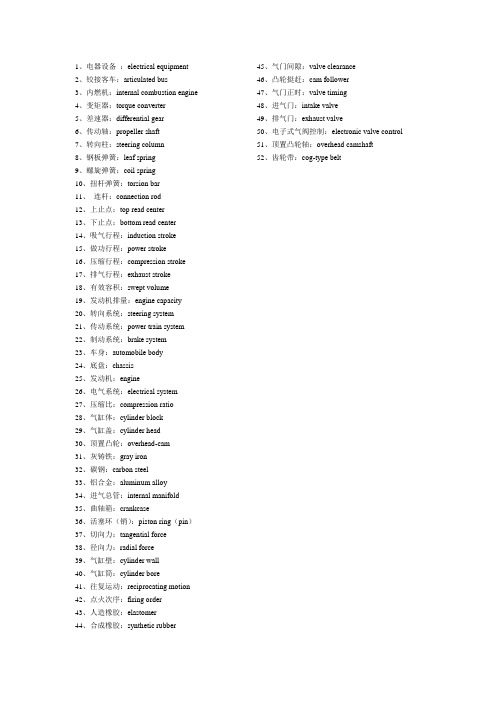
1、电器设备:electrical equipment2、铰接客车:articulated bus3、内燃机:internal combustion engine4、变矩器:torque converter5、差速器:differential gear6、传动轴:propeller shaft7、转向柱:steering column8、钢板弹簧:leaf spring9、螺旋弹簧:coil spring10、扭杆弹簧:torsion bar11、连杆:connection rod12、上止点:top read center13、下止点:bottom read center14、吸气行程:induction stroke15、做功行程:power stroke16、压缩行程:compression stroke17、排气行程:exhaust stroke18、有效容积:swept volume19、发动机排量:engine capacity20、转向系统:steering system21、传动系统:power train system22、制动系统:brake system23、车身:automobile body24、底盘:chassis25、发动机:engine26、电气系统:electrical system27、压缩比:compression ratio28、气缸体:cylinder block29、气缸盖:cylinder head30、顶置凸轮:overhead-cam31、灰铸铁:gray iron32、碳钢:carbon steel33、铝合金:aluminum alloy34、进气总管:internal manifold35、曲轴箱:crankcase36、活塞环(销):piston ring(pin)37、切向力:tangential force38、径向力:radial force39、气缸壁:cylinder wall40、气缸筒:cylinder bore41、往复运动:reciprocating motion42、点火次序:firing order43、人造橡胶:elastomer44、合成橡胶:synthetic rubber 45、气门间隙:valve clearance46、凸轮挺赶:cam follower47、气门正时:valve timing48、进气门:intake valve49、排气门:exhaust valve50、电子式气阀控制:electronic valve control51、顶置凸轮轴:overhead camshaft52、齿轮带:cog-type belt1、有些零件使汽车更舒服或更美观,但其中大多数是使汽车行驶。
机械工程专业英语的某些单词和句子翻译
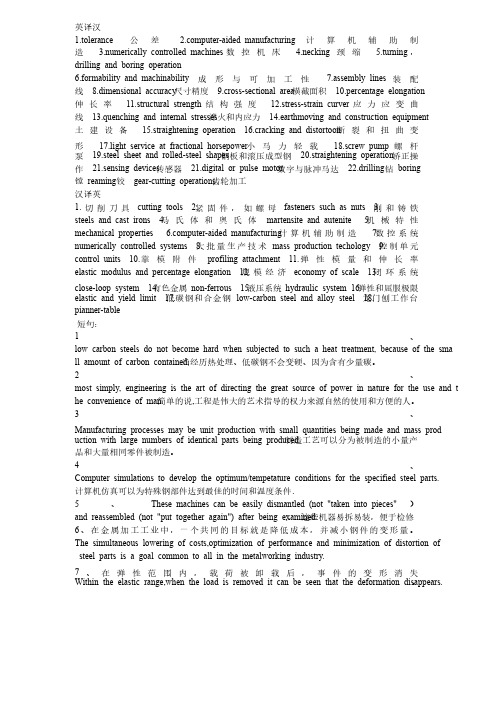
英译汉1.tolerance公差 puter-aided manufacturing计算机辅助制造 3.numerically controlled machines数控机床 4.necking颈缩 5.turning,drilling and boring operation 6.formability and machinability成形与可加工性 7.assembly lines装配线 8.dimensional accuracy尺寸精度 9.cross-sectional area横截面积 10.percentage elongation伸长率 11.structural strength结构强度 12.stress-strain curver应力应变曲淬火和内应力 14.earthmoving and construction equipment线 13.quenching and internal stresses土建设备 15.straightening operation 16.cracking and distortoon断裂和扭曲变形 17.light service at fractional horsepower小马力轻载 18.screw pump螺杆泵 19.steel sheet and rolled-steel shapes钢板和滚压成型钢 20.straightening operation矫正操作 21.sensing devices 传感器 21.digital or pulse motor数字与脉冲马达 22.drilling钻 boring齿轮加工镗 reaming铰 gear-cutting operations齿轮加工汉译英1.切削刀具cutting tools 2.紧固件,如螺母fasteners such as nuts 3.刚和铸铁steels and cast irons 4.马氏体和奥氏体martensite and autenite 5.机械特性mechanical properties puter-aided manufacturing计算机辅助制造 7.数控系统numerically controlled systems 8.大批量生产技术mass production techology 9.控制单元control units 10.靠模附件profiling attachment 11.弹性模量和伸长率elastic modulus and percentage elongation 12.规模经济economy of scale 13.闭环系统close-loop system 14.有色金属non-ferrous 15.液压系统hydraulic system 16.弹性和屈服极限elastic and yield limit 17.龙门刨工作台低碳钢和合金钢low-carbon steel and alloy steel 18.pianner-table 短句:1、low carbon steels do not become hard when subjected to such a heat treatment, because of the sma ll amount of carbon contained.当经历热处理、低碳钢不会变硬、因为含有少量碳。
(完整word版)英语专业综合英语1翻译句子
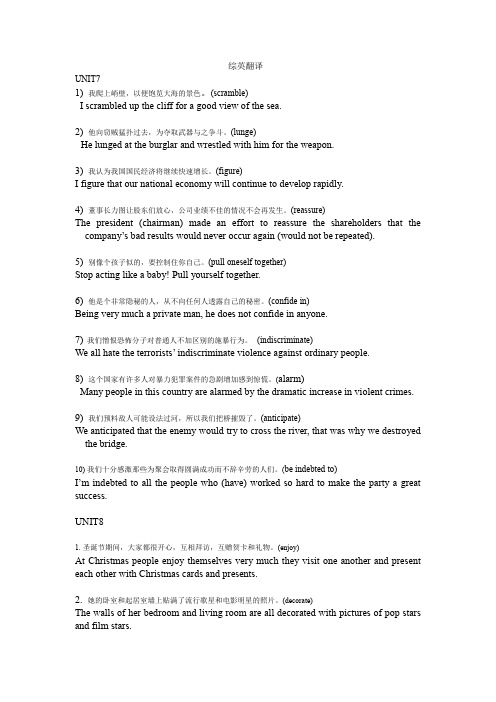
综英翻译UNIT71) 我爬上峭壁,以便饱览大海的景色。
(scramble)I scrambled up the cliff for a good view of the sea.2) 他向窃贼猛扑过去,为夺取武器与之争斗。
(lunge)He lunged at the burglar and wrestled with him for the weapon.3) 我认为我国国民经济将继续快速增长。
(figure)I figure that our national economy will continue to develop rapidly.4) 董事长力图让股东们放心,公司业绩不佳的情况不会再发生。
(reassure)The president (chairman) made an effort to reassure the shareholders that the company’s bad results would never occur again (would not be repeated).5) 别像个孩子似的,要控制住你自己。
(pull oneself together)Stop acting like a baby! Pull yourself together.6) 他是个非常隐秘的人,从不向任何人透露自己的秘密。
(confide in)Being very much a private man, he does not confide in anyone.7)我们憎恨恐怖分子对普通人不加区别的施暴行为。
(indiscriminate)We all hate the terrorists’ indiscriminate violence against ordinary people.8) 这个国家有许多人对暴力犯罪案件的急剧增加感到惊慌。
(alarm)Many people in this country are alarmed by the dramatic increase in violent crimes.9) 我们预料敌人可能设法过河,所以我们把桥摧毁了。
会计专业英语复习单词和句子翻译

1 Lession Lession 11 Information system 信息系统信息系统 Modern business 现代企业现代企业 Financinal position 财务状况财务状况 Financial data 财务数据财务数据 Financial strength 财务实力财务实力 Financial report 财务报告财务报告Accounting process 会计过程,会计处理方法处理方法Financial accounting 财务会计财务会计 Decision making 决策决策Managerial accounting 管理会计管理会计 Financial executives 财务经理财务经理 Performance report 业绩报告业绩报告 Cost-benefit data 成本-效益数据效益数据 Cost accounting 成本会计成本会计 T ax accounting 税务会计税务会计Budgetary accounting 预算会计预算会计Governmental and not-for-profit accounting 政府及非营利组织会计 Human resources accounting 人力资源会计资源会计Environmental accounting 环境会计Social accounting 社会会计社会会计International accounting 国际会计国际会计 T ax returns 纳税申报单纳税申报单Lesson 2Financial statement statement (report) (report) 财务报表(报告)(报告)Balance sheet 平衡表,资产负债表平衡表,资产负债表 Income statement 收益表,损益表收益表,损益表 Statement of cash flows 现金流量表 Owners Owners’’ equity 业主权益业主权益 At a glance 一瞥一瞥Accounting equation 会计等式,会计平衡式,会计方程式平衡式,会计方程式Current asset 流动资产流动资产 Long-term asset 长期资产长期资产Normal operating cycle 正常经营周期Other than 除……外,处了外,处了Marketable securities 上市证券,有价证券证券Accounts receivable 应收帐款应收帐款 Prepaid insurance 预付保险费预付保险费 Supplies on hand 在用物料在用物料 Fixed assets 固定资产固定资产 Rather than 而不是而不是Plant and equipment 厂场设备厂场设备 Depreciable asset 应折旧资产应折旧资产 Original cost 原始成本原始成本 Store fixtures 店面装置店面装置Accumulated depreciation 累计折旧,累积折旧累积折旧Book value 账面价值账面价值 Intangible asset 无形资产无形资产Lession3 Current liability 流动负债流动负债 Notes payable 应付票据应付票据Accrued salaries payable 应付账款应付账款 Accured salaries p ayable payable 应计未付薪金应计未付薪金 Income tax payable 应付所得税应付所得税 Property tax payable 应付财产税应付财产税 Mortgage payable 应付抵押借款应付抵押借款Bonds payable 应付债券,应付公司券应付债券,应付公司券 Sole proprietorship 独资独资State corporation law 州公司法(美国)国)Capital stock 股本股本Retained earnings 留存收益,保留盈利留存收益,保留盈利 Legal restrictions 法律约束法律约束Undistributed earnings 未分配收益,未分配盈利分配盈利 Engage in 参与参与Board of directors 董事会董事会 Divedend payable 应付股利应付股利Lesson4Merchandising company 商业公司商业公司 Net income 净收益净收益 Net loss 净损失净损失Operating results 经营成果经营成果Cost of goods sold 销售成本,商品销售成本销售成本Operating expenses 营业费用,经营费用Sales returns and allowances 销货退回及折让退回及折让Sales discounts 销货(售)折让销货(售)折让 Gross sales 销货(售)总额销货(售)总额 Net sales 销货(售)净额销货(售)净额 Beginning inventory 期初存货期初存货 Net purchases 购货净额购货净额 Ending inventory 期末存货期末存货Purchases returns and allowances 购货退还及折让货退还及折让Purchases discounts 购货折扣购货折扣 Transportation in 购货运费购货运费 Transportation out 销货运费销货运费Cost of goods available for sale 可供销售的商品成本可供销售的商品成本Gross profit on sales 销货(售)毛利毛利 Selling expenses 销货(售)费用销货(售)费用 Administrative expenses 管理费用管理费用 Sales salaries expense 销货(售)人员薪金员薪金Advertising expenses 广告费广告费 Depreciation expense 折旧费折旧费 Insurance expense 保险费保险费 Rent expense 租赁费,租金租赁费,租金Office salaries expense 办事人员薪金办事人员薪金 Utilities expense 公用事业(水、电、热)费热)费Supplies expense 物料用品费物料用品费 Interest expense 利息收益利息收益 Interest income 利息费用利息费用 Relate to 与……有关有关Financial income and ex pense 财务收益和费用收益和费用Extraordinary items 非常项目非常项目Lession5“two-column ” account 两栏式账户两栏式账户 Normal balance 正常余额正常余额Double-entry bookkeeping system 复式记账法,复式记账系统式记账法,复式记账系统Source document 原始凭证原始凭证 Check stub 支票存根支票存根 A set of 一组,一套一组,一套Records of original entry 原始记录簿Chart of accounts 账户一览表,会计科目表科目表Income summary 收益汇总,损益汇总收益汇总,损益汇总 Control account 控制账户,统驭账户,统制账户统制账户Subsidiary ledger 辅助分类账,明细分类账类账Perpetual inventory system 永续盘存制Lession 6Special journal 特种日记账特种日记账 General journal 普通日记账普通日记账In consrast to 与此对比,与此相反与此对比,与此相反 In addition to 除。
专业英语句子翻译

石油工程专业英语重点段落翻译
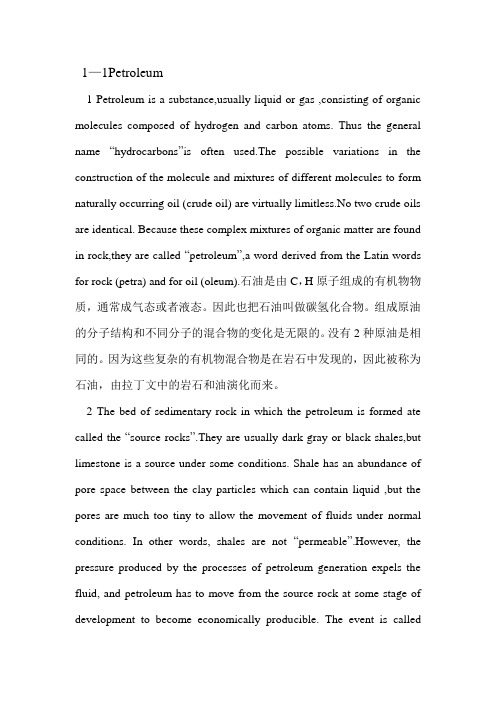
1—1Petroleum1 Petroleum is a substance,usually liquid or gas ,consisting of organic molecules composed of hydrogen and carbon atoms. Thus the general name “hydrocarbons”is often used.The possible variations in the construction of the molecule and mixtures of different molecules to form naturally occurring oil (crude oil) are virtually limitless.No two crude oils are identical. Because these complex mixtures of organic matter are found in rock,they are called “petroleum”,a word derived from the Latin words for rock (petra) and for oil (oleum).石油是由C,H原子组成的有机物物质,通常成气态或者液态。
因此也把石油叫做碳氢化合物。
组成原油的分子结构和不同分子的混合物的变化是无限的。
没有2种原油是相同的。
因为这些复杂的有机物混合物是在岩石中发现的,因此被称为石油,由拉丁文中的岩石和油演化而来。
2 The bed of sedimentary rock in which the petroleum is formed ate called the “source rocks”.They are usually dark gray or black shales,but limestone is a source under some conditions. Shale has an abundance of pore space between the clay particles which can contain liquid ,but the pores are much too tiny to allow the movement of fluids under normal conditions. In other words, shales are not “permeable”.However, the pressure produced by the processes of petroleum generation expels the fluid, and petroleum has to move from the source rock at some stage of development to become economically producible. The event is called“primary migration”.Once departed from the source bed ,the oil or gas will enter any nearby porous and permeable rock ,such as sandstone or limestone.能够形成石油的沉积岩层称为生油岩。
机械专业英语(章跃版)课后英汉翻译(最全)

第一章:应力与应变1.That branch of scientific analysis which motions, times and forces is called mechanics and is made up of two parts, statics and dynamics.研究位移、时间和力运动乘力是科学分析法的一个分歧,被称作力学,力学由两大部分组成,静力学和动力学。
2.For example, if the force operating on a sleeve bearing becomes too high, it will squeeze out the oil film and cause metal-to-metal contact, overheating and rapid failure of the bearing.例如:如果止推轴承上的作用力过大的话,会挤出油膜,引起金属和金属之间的相互接触,轴承将过热而迅速失效。
3.Our intuitive concept of force includes such ideas as place of application, direction, and magnitude, and these are called the characteristics of a force.力的直观概念包括力的作用点、大小、方向,这些被称为力的三要素。
4.All bodies are either elastic or plastic and will be deformed if acted upon by forces. When the deformation of such bodies is small, they are frequently assumed to be rigid, i.e., incapable of deformation, in order to simplify the analysis.所有的物体既可以是弹性的也可以是塑性的,如果受到力的作用就产生变形。
计算机专业英语句子翻译
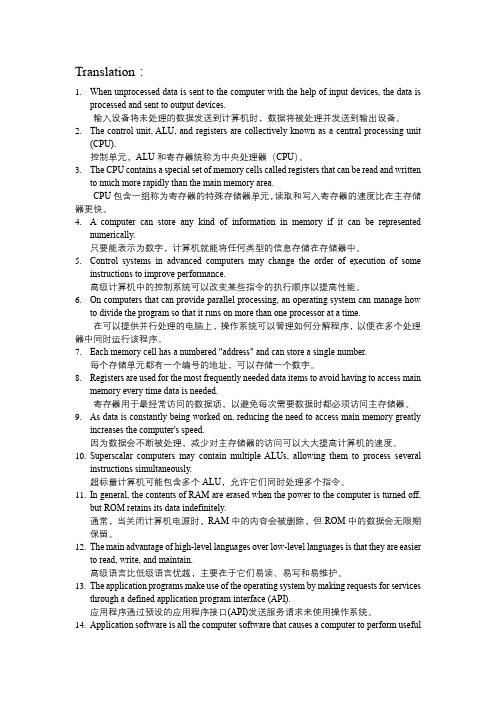
Translation:1.When unprocessed data is sent to the computer with the help of input devices, the data isprocessed and sent to output devices.输入设备将未处理的数据发送到计算机时,数据将被处理并发送到输出设备。
2.The control unit, ALU, and registers are collectively known as a central processing unit(CPU).控制单元,ALU和寄存器统称为中央处理器(CPU)。
3.The CPU contains a special set of memory cells called registers that can be read and writtento much more rapidly than the main memory area.CPU包含一组称为寄存器的特殊存储器单元,读取和写入寄存器的速度比在主存储器更快。
4. A computer can store any kind of information in memory if it can be representednumerically.只要能表示为数字,计算机就能将任何类型的信息存储在存储器中。
5.Control systems in advanced computers may change the order of execution of someinstructions to improve performance.高级计算机中的控制系统可以改变某些指令的执行顺序以提高性能。
6.On computers that can provide parallel processing, an operating system can manage howto divide the program so that it runs on more than one processor at a time.在可以提供并行处理的电脑上,操作系统可以管理如何分解程序,以便在多个处理器中同时运行该程序。
会计专业英语复习单词和句子翻译
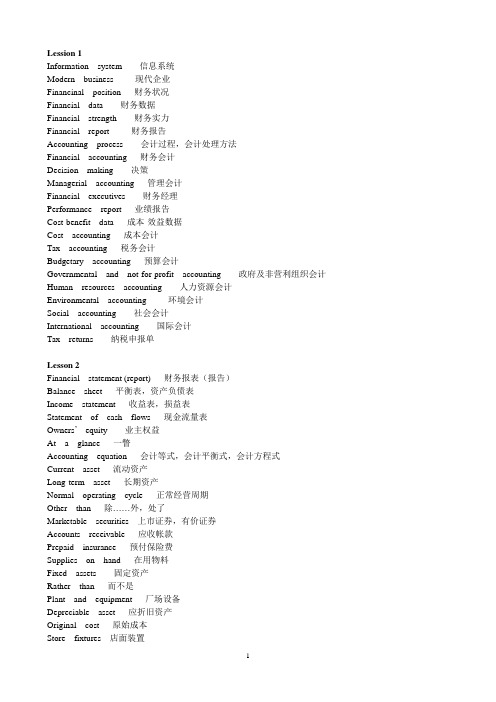
Lession 1Information system 信息系统Modern business 现代企业Financinal position 财务状况Financial data 财务数据Financial strength 财务实力Financial report 财务报告Accounting process 会计过程,会计处理方法Financial accounting 财务会计Decision making 决策Managerial accounting 管理会计Financial executives 财务经理Performance report 业绩报告Cost-benefit data 成本-效益数据Cost accounting 成本会计Tax accounting 税务会计Budgetary accounting 预算会计Governmental and not-for-profit accounting 政府及非营利组织会计Human resources accounting 人力资源会计Environmental accounting 环境会计Social accounting 社会会计International accounting 国际会计Tax returns 纳税申报单Lesson 2Financial statement (report) 财务报表(报告)Balance sheet 平衡表,资产负债表Income statement 收益表,损益表Statement of cash flows 现金流量表Owners’equity 业主权益At a glance 一瞥Accounting equation 会计等式,会计平衡式,会计方程式Current asset 流动资产Long-term asset 长期资产Normal operating cycle 正常经营周期Other than 除……外,处了Marketable securities 上市证券,有价证券Accounts receivable 应收帐款Prepaid insurance 预付保险费Supplies on hand 在用物料Fixed assets 固定资产Rather than 而不是Plant and equipment 厂场设备Depreciable asset 应折旧资产Original cost 原始成本Store fixtures 店面装置Accumulated depreciation 累计折旧,累积折旧Book value 账面价值Intangible asset 无形资产Lession3Current liability 流动负债Notes payable 应付票据Accrued salaries payable 应付账款Accured salaries payable 应计未付薪金Income tax payable 应付所得税Property tax payable 应付财产税Mortgage payable 应付抵押借款Bonds payable 应付债券,应付公司券Sole proprietorship 独资State corporation law 州公司法(美国)Capital stock 股本Retained earnings 留存收益,保留盈利Legal restrictions 法律约束Undistributed earnings 未分配收益,未分配盈利Engage in 参与Board of directors 董事会Divedend payable 应付股利Lesson4Merchandising company 商业公司Net income 净收益Net loss 净损失Operating results 经营成果Cost of goods sold 销售成本,商品销售成本Operating expenses 营业费用,经营费用Sales returns and allowances 销货退回及折让Sales discounts 销货(售)折让Gross sales 销货(售)总额Net sales 销货(售)净额Beginning inventory 期初存货Net purchases 购货净额Ending inventory 期末存货Purchases returns and allowances 购货退还及折让Purchases discounts 购货折扣Transportation in 购货运费Transportation out 销货运费Cost of goods available for sale 可供销售的商品成本Gross profit on sales 销货(售)毛利Selling expenses 销货(售)费用Administrative expenses 管理费用Sales salaries expense 销货(售)人员薪金Advertising expenses 广告费Depreciation expense 折旧费Insurance expense 保险费Rent expense 租赁费,租金Office salaries expense 办事人员薪金Utilities expense 公用事业(水、电、热)费Supplies expense 物料用品费Interest expense 利息收益Interest income 利息费用Relate to 与……有关Financial income and expense 财务收益和费用Extraordinary items 非常项目Lession5“two-column”account 两栏式账户Normal balance 正常余额Double-entry bookkeeping system 复式记账法,复式记账系统Source document 原始凭证Check stub 支票存根A set of 一组,一套Records of original entry 原始记录簿Chart of accounts 账户一览表,会计科目表Income summary 收益汇总,损益汇总Control account 控制账户,统驭账户,统制账户Subsidiary ledger 辅助分类账,明细分类账Perpetual inventory system 永续盘存制Lession 6Special journal 特种日记账General journal 普通日记账In consrast to 与此对比,与此相反In addition to 除。
中医专业英语课后短语及句子翻译

Unit1Test A1.differentiating syndromes and treatment 辨证论治2.syndrome differentiation with eight principles 八纲辨证location of diseases 病变部位tendency of pathological changes 病势external disease factors 外感病邪duration of a disease 病程aversion to cold 恶寒nasal congestion 鼻塞sore,itchy throat 喉痒咽痛penetrate from the superficial layers to the interior of the body 由表传里changes in tongue coating 舌苔变化cold limbs 四肢厥冷pallor/pale face 面色苍白clear and copious urine 小便清长absence of thirst 口不渴primary disease 原发病pale tongue with white coating 舌淡苔白malar flush 颧红struggle between the anti-pathogenic factors and pathogenic factors 正邪相争yang/yin depletion/collapse 亡阳/亡阴reduced appetite 食欲减退abdominal distention 腹部胀满qi transformation 气化pseudo-cold and real heat 真寒假热二句子翻译The clinical manifestations of diseases, though intricate, can be analyzed with the eight principles according to the category, location and nature of disease as well as the conflict between the anti-pathogenic factors and pathogenic factors.疾病的临床表现尽管错综复杂,但基本上都可以用八纲从疾病的类别、病性、邪正盛衰方面进行分析。
电气工程 专业英语 单词 句子 翻译

名词解释:1.集成电路Integrated circuit2.可编程逻辑控制器prpgrammable logic controller3.暂态/稳态过程steady state process4.有功/无功/视在功率active/ reactive/ apparent output5.品质因数quality factor6.低通/高通/带通滤波器low pass filter/ high-peaker / band passfilter7.单位负反馈unit reverse feedback8.温度/湿度/压力传感器temperature/ humidity/ pressure sensor9.片内/外存储chip-on/off memory10.控制理论与控制工程control theory and control engineering11.升/降压变压器step-up/step-down transformer12.发射极/集电极/基极emitter/ collector/ base13.遥感remote sensing14.三相异步感应电机three-phase asynchronous inductionmachine15.交流电机a-c dynamo16.直流电机continuous current dynamo17.三相对称电源symmetrical three-phase source18.三相四线制three-phase four-wire system19.结点电压nodal point voltage20.网孔电流mesh current21.正弦稳态响应sine steady state response22.逐次逼近approach gradually23.发电机dynamo24.太阳能/潮汐/风力发电solar energy / tide/ wind power dynamo25.拉普拉斯变换Laplace transform26.过程控制process control27.电流互感器current transformer28.相位超前/滞后phase advance/ lag29.温度调节器temperature regulator30.(非)线性控制系统(nonlinear) linear control system31.误差校正correction of error32.故障诊断fault diagnosis33.理想运放ideal operational amplifier34.工厂供电plant power supply35.架空传输线overhead transmission line36.串/并联谐振series/ parallel resonance37.面向对象编程object-oriented programming38.异步电机asynchronous machine39.人工智能artificial intelligence40.多智能体multi-agent41.特征方程characteristic equation42变频空调air-condition of frequency conversion42.电机拖动electrical drive43.局域网协议local area network agreement44.汽车电子auto electron45.楼宇自动化building automation46.采样保持sample hold47.嵌入式系统embedded system 48.半导体技术semiconductor technology49.模拟/数字电子技术analog/ digital electronic technique50.网络互连协议internet protocol51.断路器circuit breaker52.继电器relay53.继电保护relay protection54.电力系统及其自动化electric power system and its automation 专英翻译句子:1、晶体三极管的输入输出特性曲线测试是模拟电子技术中最基本的实验之一。
车辆工程专业英语核心考点句子翻译

Chapter 1 Automotive Basics(汽车基础)(1) Today s average car contains more than 15,000 separate, individual parts that must work together. These parts can be grouped into four major categories: body, engine, chassis and electrical equipment 。
当今的车辆一般都由15000多个分散、独立且相互配合的零部件组成。
这些零部件主要分为四类:车身、发动机、底盘和电气设备。
1.1 Body(车身)(2) The body is designed to keep passengers safe and comfortable. The body styling provides an attractive, colorful, modern appearance for the vehicle. 车身的设计要保证乘客安全舒适。
车身的款式使得汽车看起来漂亮迷人、色彩斑斓、时尚前卫。
1.2 Engine(发动机)(3)The internal combustion engine is most common: this obtains its power by burning a liquid fuel inside the engine cylinder. There are two types of engine: gasoline and diesel . Both engines are called heat engines; the burning fuel generates heat which causes the gas inside the cylinder to increase its pressure and supply power to rotate a shaft connected to the transmission . 内燃机是最常见的,其动力来自气缸里液体燃料的燃烧。
信息管理专业英语 unit1-12 单词以及句子翻译

专业英语一、专业术语RFID射频识别IOT物联网Cloud Computing云计算ANN神经网络BI商业智能E-business /Web-business / e-commerce电子商务KM知识管理GIS地理信息系统PDA掌上电脑Bluetooth蓝牙技术CAD计算机辅助设计CMD计算机辅助制作branch manager部门经理binary format二进制格式USB(Universal Serial Bus)通用串行总线computer case计算机机箱temporary storage of information临时存储信息floppy disk软盘CD-ROM只读光盘textual源代码video card视频卡,显卡sound card音频卡,声卡DVD数字化视频光盘SISP战略信息系统计划Project Management项目管理Human Resources人力资源End-User Systems Development最终用户系统开发rolling business plans流动业务计划MIS(management information system)管理信息系统DB(database)数据库DBMS(database Management system)数据库管理系统DSS(decision support system)决策支持系统operational manager运营经理Senior manager 高级经理semi-structured decision半结构化决策ANS(Advanced Network&Service)高级网络及服务公司TPS(Transaction Processing systems)事务管理系统KWS(Knowledge Work Systems)只是工作系统GRASP绘制机器人技术应用软件包OAS(Office Automation Systems)办公自动化系统ESS(Executive Support Systems)经理支持系统EIS(Executive Information Systems)经理信息系统OLAP(on-line analytical processing)联机分析处理GIS(Group Information Systems)集群信息系统GDSS(Group Decision Support Systems)集群决策支持系统MIT(Management Information technology)管理信息技术RAD(rapid application development)快速应用开发Two-way communications 双工通讯client-server environment 客户服务环境Data warehouse 数据仓库logistics information systems 物流信息系统ERP(Enterprise resource planning)企业资源规划CRM(customer relationship Management)客户关系管理OOD(Object-Oriented design)面向对象设计OOP(Object0Oriented Programming)面向对象编程HLLs(High Level Languages)高级语言ADTs(Abstract Data Types)抽象数据类型Software Ics软件的组成单元machine code机器码op-code输出码EDI(Electronic Data interchange)电子数据交换SMEs(small and medium sized enterprises)中小企业B2B企业对企业电子商务B2C企业对用户电子商务CERT(Character Error Rate Tester)字符出错率测试器CIAS(Communication Link Analyzer System)通信链路分析系统IMS(Information Management System)管理信息系统NDMS(Netware Data Management System)网络数据管理系统二、翻译Unit 11. Management is the attainment of organizational goals in an effective and efficient manner through planning, organizing, leading, and controlling organizational resources.管理是组织目标通过计划、组织、领导、控制组织资源实现的有效方式。
- 1、下载文档前请自行甄别文档内容的完整性,平台不提供额外的编辑、内容补充、找答案等附加服务。
- 2、"仅部分预览"的文档,不可在线预览部分如存在完整性等问题,可反馈申请退款(可完整预览的文档不适用该条件!)。
- 3、如文档侵犯您的权益,请联系客服反馈,我们会尽快为您处理(人工客服工作时间:9:00-18:30)。
Unit 1 (5个)1.Materials science and engineering (MSE) is an interdisciplinary field concerned with inventing new materials and improving previously known materials by developing a deeper understanding of the microstructure-composition-synthesis-processing relationships.2.Materials scientists and engineers not only deal with the development of materials, but also with the synthesis and processing of materials and manufacturing processes related to the production of components.3.One of the most important functions of materials scientists and engineers is to establish the relationships between a material or a device’s properties and performance and the microstructure of that material, its composition, and the way the material or the device was synthesized and processed.4.In materials science, the emphasis is on the underlying relationships between the synthesis and processing, structure, and properties of materials.5.In materials engineering, the focus is on how to translate or transform materials intoa useful device or structure.Unit 2(3个)6.What is also fascinating about van der Waals forces is that they begin as inter actions between atoms and molecules that ultimately lead to considerable forces between fine particles of any material.7. We make use of metal and ceramic powders (dry or slurries) in processing many ceramic and metallic materials through routes collectively known as powder processing (Processing technique for metals involving the solid-state bonding of a fine grained powder into a fully dense product).8.We can accomplish this by introducing like charges on the particles (electrostatic stabilization) or adsorbing soap like surfactant molecules on the surfaces of particles (steric stabilization).Unit 3(8个)9.The Si-O bond in the SiO44- structure in about 50 percent covalent and 50 percent ionic according to calculations from Pauling’s equation.10.The tetrahedral coordination of SiO44- satisfies the directionality requirement of covalent bonding and the radius ratio requirement of ionic bonding.11.If two corners of each SiO44-tetrahedron are bonded with the corners of other tetrahedra, a chain or ring structure with the unit chemical formula of SiO32- results.12.Silicate sheet structure form when three corners in the same plane of a silicate tetrahedron are bonded to the corners of three silicate tetrahedra.13.The mineral['mɪnərəl](矿物的,矿物)kaolinite['keɪəlɪnaɪt](高岭石)consists (in its pure form) of every small, flat plates roughly hexagonal[hek'sæɡənəl](六边的,六角形的) in shape, with their average size being about 0.7um in diameter[daɪ'æmɪtə](直径) and 0.05 um thick.14.Another example of a sheet silicate is the mineral talc[tælk](滑石;云母), in which a sheet of Mg3(OH)24+ bonds with two outer-layer Si2O52- sheets (one on each side) to form a composite['kɒmpəzɪt](复合的;合成的)sheet with the unit chemical formula['fɔːmjʊlə](公式,方程式) Mg3(OH)2(Si2O5)2.15.Crystalline['krɪst(ə)laɪn](结晶的)silica exists in several polymorphic[,pɒlɪ'mɔːfɪk](多态的)forms that correspond to different ways in which the silicate tetrahedral are arranged with all corners shared.16.The most stable forms of silica and the temperature ranges in which they exist at atmospheric pressure are low quartz[kwɔːts](石英) below 573℃, high quartz between 573 to 867℃, high tridymite['trɪdɪmaɪt](鳞石英)between 867 and 1470℃, and high cristobite[kris'təu,bəlait](方石英) between 1470 and 1710℃.Unit 4(15个)17.Point defects(点缺陷)are localized['lokə'laɪzd](局部的;地区的;小范围的) disruptions[dɪs'rʌpʃən](破坏) in otherwise perfect atomic or ionic arrangements in a crystal structure.18.These imperfections, may be introduced by movement of the atoms or ions when they gain energy by heating, during processing of the material, by introduction of impurities, or doping[dop](掺杂).19.An important "point" about point defects is that although the defect occurs at one or two sites, their presence is "felt" over much larger distances in the crystalline material.20. When atoms or ions are missing (i.e., when vacancies are present), the overall randomness['rændəmnɪs](随意;无安排;不可测性) or entropy['entrəpɪ](熵) of the material increases, which increases the thermodynamic[,θɜːməʊdaɪ'næmɪk](热力学的) stability of a crystalline material.21.V acancies['vekənsi](空位)play an important role in determining the rate at which atoms or ions can move around, or diffuse[dɪ'fjuːz](弥散,扩散)in a solid material, especially in pure metals.22.If we conduct(管理;引导;表现) this sintering['sɪntərɪŋ](烧结) treatment in a reducing or inert atmosphere (e.g., hydrogen or nitrogen), some of the oxygen ions from BaTiOa will leave the material in the form of oxygen gas.23.In some cases, we can introduce vacancies at specific ion sites so as to enhance the movement of ions in ceramic materials, which can help sinter ceramics[ɪn'hɑːns](提高;加强;增加) at lower temperatures.24.At room temperature(~298K), the concentration[kɒns(ə)n'treɪʃ(ə)n](集中,浓度)of vacancies is small, but the concentration of vacancies increases exponentially[,ɛkspo'nɛnʃəli](以指数方式)as we increase the temperature, as shown by the following Arrhenius type behavior:25.Interstitial[,ɪntə'stɪʃ(ə)l](间质的;空隙的;填隙的)atoms or ions,although much smaller than the atoms or ions located at the lattice['lætɪs](晶格;格子) points,are still larger than the interstitial sites that they occupy; consequently, the surrounding crystal region['riːdʒ(ə)n](范围) is compressed and distorted[dɪs'tɔrtɪd](扭曲).26.Interstitial atoms such as hydrogen['haɪdrədʒ(ə)n](氢)are often present as impurities; whereas[weər'æz](然而;鉴于;反之) carbon atoms are intentionally added to iron to produce steel.27.If there are dislocations(变位;位移;断错) in the crystals trying to move around these types of defects, they face a resistance to their motion, making it difficult to create permanent deformation(永久性变形) in metals and alloys.28.Substitutional[,sʌbstə'tjʊʃənl](置换)atoms or ions may either be larger than the normal atoms or ions in the crystal structure, in which case the surrounding inter-atomic spacings are reduced, or smaller causing the surrounding atoms to have larger inter-atomic spacings.29.Whether atoms or ions added go into interstitial or substitutional sites depends upon the size and valence of guest atoms or ions compared to the size and valence of host ions.Unit 5(10个)30.Semiconductors(半导体) which do not contain appreciable[ə'priːʃəb(ə)l](可感知的;可评估的;相当可观的)levels of dopants or impurities are known as intrinsic[ɪn'trɪnsɪk](本质的,固有的)semiconductors, When we add small concentrations of P or B to silicon crystal, these atoms occupy crystallographic[,krɪstəlɑ'ɡræfɪk](结晶的) sites where silicon atoms usually reside(住,居住;属于).31.The result is each P atom added has one "extra" electron that cannot pair with a Si atom to form a fifth Si-P bond.32.The entire microelectronics[,maɪkrəʊɪlek'trɒnɪks]微电子学) industry, as we know it today, would not exist if we did not have a good understanding of the diffusion of different atoms into silicon or other semiconductors.33.Strong covalent[,ko'velənt](共价的)and ionic bonds along with microstructural features contribute to the relatively poor electrical conductivity exhibited[ɪg'zɪbɪt] by many ceramics.34.The ability of ions to diffuse and provide a pathway for electrical conduction plays an important role in enabling these applications.35.This is one of the major reasons why we use polyethylene terephthalate (PET聚对苯二甲酸乙二醇酯) to make bottles which ensure that the carbonated beverages['bev(ə)rɪdʒ](饮料) they contain will not loose their fizz(兴奋,活力;嘶嘶声;充气饮料) for a reasonable period of time.36.In reality, aluminum[ə'ljuːmɪnəm]oxidizes['ɒksɪdaɪz](氧化)(rusts) more easily than iron. However, the aluminum oxide (Al2O3) forms a very protective but thin coating on the aluminum’s surface preventing any further diffusion of oxygen and hindering(妨碍) further oxidation of the underlying aluminum.37.We distinguish[dɪ'stɪŋgwɪʃ](区分)between the movement of atoms, molecules['mɑlə,kjʊl], ions, electrons, holes, etc. as a result of concentration gradient['greɪdɪənt](梯度)and temperature (diffusion) or some other driving force, such as gradients in density['densɪtɪ](密度), electric field, or magnetic field gradients.38.This equation is derived from(来自,源自于) a statistical analysis(统计分析) of the probability that the atoms will have the extra energy Q needed to cause movement. 39.The disorder vacancies create (i.e., increased entropy) helps minimize the free energy and, therefore, enhance the thermodynamic stability of a crystalline material.40.In chapter 3, we have seen that for many ceramics with ionic bonding the structure can be considered as close packing(密集流水) of anions(阴离子)with cations(阳离子;正离子) in the interstitial sites.41.At higher temperatures, the thermal['θɜːm(ə)l](热的)energy supplied to the diffusing atoms permits the atoms to overcome the activation energy(活化能) barrier and more easily move to new sites in the atomic arrangements.Unit 6(9个)42.Since melting, casting, and thermomechanical[,θə:məumi'kænikəl](热] 热机的,[热] 热机械的)processing is not a viable['vaɪəbl](可行的;能养活的;能生育的)option for polycrystalline[,pɑlɪ'krɪstə'laɪn](多晶)ceramics, we typically process ceramics intouseful shapes starting with ceramic powders.43.In this process, the green ceramic is heated to a high temperature, using a controlled heat and atmosphere, so that a dense material is obtained.44.Powders consist of particles that are loosely bonded, and powder processing involves the consolidation[kən,sɒlɪ'deɪʃən](巩固;合并;团结) of these powders into a desired shape.45.In some cases, very large pieces (up to a few feet in diameter and six to eight feet long) can be produced using a process called cold isostatic pressing (CIP冷等静压制) where pressure is applied using oil.46.Similarly, large pieces of metals and alloys compacted['kɔmpæktid]( . 压实的;压紧的) using CIP can be sintered under pressure in a process known as hot isostatic pressing (HIP热等静压;高温等静力压制).47.Some recent innovative['ɪnəvetɪv](革新的,创新的)processes that make use of microwaves (similar to the way food gets heated in microwave oven) have also been developed for the drying and sintering of ceramic materials.48.Some ceramics, such as silicon nitride['naɪtraɪd](氮化物) (Si3N4), are produced by reaction bonding(反应粘合).49.Reaction bonding, which can be done at lower temperatures, provides better dimensional[dɪ'menʃənəl](空间的,尺寸的)control compared with hot pressing; however, lower densities and mechanical properties are obtained.50.This mixture has a clay(粘土)-lake consistency[kən'sɪst(ə)nsɪ](一致性;稠度;相容性), which is then fed to an extruder[ɛk'strudɚ](挤出机;挤压机) where it is mixed well in a pug mill(搅拌机), sheared[ʃɪəd](修剪), deaerated[di'ɛret](出去空气), and then injected(注入的) into a die(冲模,钢模;骰子)where a continuous shape of green ceramic is produced by the extruder.Unit 7(2个)51.The combination of transparency[træn'spær(ə)nsɪ](透明,透明度)and hardness at room temperature along with sufficient(足够的;充分的) strength and excellent corrosion [kə'rəʊʒ(ə)n](腐蚀)resistance to most normal environments make glasses indispensable for many engineering applications such as construction and vehicle glazing(上釉;玻璃装配业).52.However, in borosilicate[,bɔːrəʊ'sɪlɪkeɪt]glasses(硼硅酸盐玻璃) that have additions of alkali['ælkəlaɪ](碱;可溶性无机盐)and alkaline earth(碱土金属) oxides, BO33- triangles can be converted(转化) to BO44- tetrahedra, with the alkali or alkaline earth cations providing the necessary electroneutrality.Unit 8(14个)53.It reacts relatively quickly with water, and in normal Portland cements(波特兰水泥,硅酸盐水泥,普通水泥) is the most important of the constituent[kən'stɪtjʊənt](成分;选民;委托人)phases for strength development; at ages up to 28 days, it is by far the most important.54.The rate at which it reacts with water appears to be somewhat variable, perhaps due to differences in composition or other characteristics, but in general is high initially[ɪ'nɪʃ(ə)lɪ](起初的) and low or very low at later ages.55.The standard specifications(标准技术规范;标准规格) with which such cements(水泥;胶合剂) must comply[kəm'plaɪ](遵守) are similar, but not identical[aɪ'dentɪk(ə)l](同一的;完全相同的), in all countries and various names are used to define the materials, such as Class 42.5 Portland cement in current European and British standards (42.5 is the minimum 28-days compressive strength in MPa), Type I and II Portland cement in the ASTM (American Society for Testing and Materials) specifications used in USA, or Ordinary Portland Cement(OPC) in former British standards.56.Standard specifications are, in general, based partly on chemical composition or physical properties such as specific surface area, and partly on performance tests, such as setting time or compressive strength developed under standard conditions.57.The content of MgO is usually limited to 4%--5%, because quantities of this component in excess of about 2%can occur as periclase (magnesium oxide), which through slow reaction with water can cause destructive expansion of hardened concrete['kɒŋkriːt](具体物;凝结物).58.Many other minor['maɪnə](次要的,未成年的) components are limited in content by their effects on the manufacturing process, or the properties, or both, and in some cases the limits are defined in specifications.59.Rapid-hardening Portland cements have been produced in various ways, such as varying the composition to increase the alite['eilait](硅酸三钙石;A-水泥石) content, finer grinding['ɡraɪndɪŋ](磨的) of the clinker['klɪŋkə] (渣块;炼砖), and improvements in the manufacturing process, e.g., finer grinding or better mixing of the raw materials.60.The alite contents of Portland cements have increased steadily over the one and a half centuries during which the latter have been produced, and many cements that would be considered ordinary today would have been described as rapid hardening only a few decades ago.61.For both ordinary and rapid-hardening cements, both lower and upper limits may be imposed on(利用;欺骗;施加影响于) strength at 28 days, upper limits being a safeguard against poor durability[,djʊrə'bɪləti](耐久性;坚固;耐用年限)resulting from the use ofinadequate[ɪn'ædɪkwət](不充分的,不适当的) cement contents in concrete.62.Destructive expansion from reaction with sulfates['sʌlfet](硫酸盐)can occur not only if the latter are present in excessive[ɪk'sesɪv](过多的,极度的) proportion(比例) in the cement, but also from attack on concrete by sulfate solutions.63.The reaction involves the Al2O3-containging phases in the hardened cement, and in sulfate-resisting Portland cements its effects are reduced by decreasing the proportion of the aluminate phase, sometimes to zero.64.The reaction of Portland cement with water is exothermic[,eksə(ʊ)'θɜːmɪk](发热的), and while this can be advantage under some conditions because it accelerates hardening, it is a disadvantage under others, such as in the construction of large dams or in the lining of oil wells, when a cement slurry(水泥渣) has to be pumped over a large distance under pressure and sometimes at a high temperature.65.lower heat evolution[,iːvə'luːʃ(ə)n](演变;进化论;进展) can be achieved by coarse [kɔːs](粗糙的)grinding, and decreased total heat evolution by lowering the contents of alite and aluminate.66.The ASTM specifica tions include definitions of a Type II or “moderate heat of hardening” cement, and a more extreme Type IV or “low heat” cement.Unit 9(无)Unit 10(7个)posites(复合材料) are combinations of two materials in which one of the materials, called the reinforcing[,riɪn'fɔrs](增强的) phase, is in the form of fibers(纤维), sheets, or particles and is embedded[ɪm'bed](栽种,嵌入)in the other material, called the matrix['meɪtrɪks](基质) phase.68. If the composite is designed and fabricated['fæbrɪ,ket](制造,组装)correctly, it combines the strength of the reinforcement with the toughness(韧性;强健;有粘性) of the matrix to achieve a combination of desirable properties not available in any single conventional material.69.Because of the variety of available reinforcement and matrix materials, as well as the ability to combine them in a wide range of volume['vɒljuːm] fractions['frækʃ(ə)n](体积分量), composites can be produced with a broad range of properties, notably['notəbli](显著的) elastic[ɪ'læstɪk] modulus['mɒdjʊləs] (弹性系数;弹性模数), strength, and toughness combinations.70.A composite is a combination of a reinforcing phase present in the form of particles, whiskers, or fibers in a matrix that holds the discrete[dɪ'skriːt]( . 离散的,不连续的) reinforcement pieces together and provides them with lateral support.71.Many composites occur naturally。
